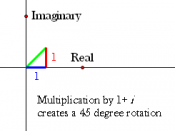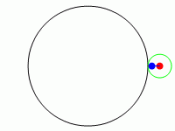Some terms in the English language may be somewhat misleading, for example, a white lie. Right now you might be thinking: How can a lie be white? In the English language it is a lie that is intentioned to help in a good way but is not the truth. The same applies to many other words like imaginary numbers and real numbers. An imaginary number doesn't mean a non-existent number and a real number doesn't necessarily mean an existing number (or maybe it does in the sense that it really is a number). Imaginary numbers are no less "real" than real numbers.
Imaginary numbers are numbers that can be written as a real number times i. The term "imaginary" probably came from the fact that there is no real number that, when squared, equals one. What is i? It's the square root of -1. It seems weird to imagine any number having a negative square.
Though it seems impossible, it really does exist in a number system called the Complex Number System. i was invented because people wanted to be able to take square roots of negative numbers, and you can't do that if you only limit yourself to real numbers.
Real numbers are composed of two categories: rational and irrational numbers. A rational number is a number that can be expressed as a fraction, for example 3/4. On the other hand, an irrational number is a number that cannot be expressed as a fraction, but as a decimal. For instance, pi. It's a continuous decimal that cannot be put into a fraction. Since i is not a rational or irrational number, then it is also NOT a real number.
The English language can lend itself to be used for other purposes. When you first heard about a white lie...



Good
indeed, it is good
0 out of 0 people found this comment useful.